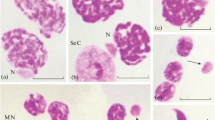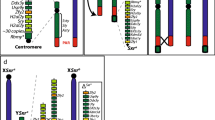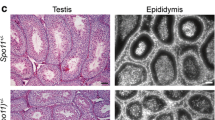Summary
Males of the composition XC2/B S Yy + were collected as prepupae, aged an additional 48 hours, then irradiated with 1000 r and brooded individually for eight days with three virginy w f females each day. Analysis suggests that brood days 1–3 represent the recovery of cells which were predominantly spermatids at the time of treatment, those from brood days 4–6 predominantly spermatocytes, and those from brood days 7–8 predominantly spermatogonia. The highest frequency of loss of individual Y markers and “X0” males, as well as the smallest F1 population size was found in broods 5 and 6, and especially in brood 6. Further analysis suggests that the vast majority of individual Y-marker losses recovered from diploid cells (spermatocytes, spermatogonia) arose independent of inter-Y arm exchange and Y-autosome translocations. In general, the data confirm the suggestive results of other investigators that deletions are recovered most readily from spermatocytes than from any other stage in spermatogenesis.
Similar content being viewed by others
Literature
Auerbach, C.: Sensitivity of theDrosophila testis to the mutagenic action of X-rays. Z. indukt. Abstamm.-u. Vererb.-L.86, 113 (1954).
Brosseau, G. E., B. Nicoletti, E. H. Grell, andD. L. Lindsley: Production of altered Y chromosomes bearing specific sections of the X chromosome inDrosophila. Genetics46, 339 (1961).
Chandley, A. C.: The induction of mutations in spermatocytes ofDrosophila melanogaster with X-rays. Int. J. Radiat. Biol.5, 305 (1962).
—, andA. J. Bateman: Mutagenic sensitivity of sperm, spermatids, spermatocytes and spermatogonia inDrosophila melanogaster. Heredity15, 363 (1960).
Frye, S.: Structure of “yellow” mutations induced by an X-ray dose of 500 r of scute-8 chromosomes of mature sperm. Drosoph. Inform. Serv.37, 76 (1963).
Khishin, A. F. E.: The response of the immature testis ofDrosophila to the mutagenic action of X-rays. Z. indukt. Abstamm.-u. Vererb.-L.87, 97 (1955).
Oakberg, E. F.: Sensitivity and time of degeneration of spermatogenic cells irradiated in various stages of maturation in the mouse. Radiat. Res.2, 369 (1955).
Oster, I. I.: Modification of X-ray mutagenesis inDrosophila. I. Reunion of chromosomes irradiated during spermiogenesis. Genetics40, 692 (1955).
Oster, I. I.: The spectrum of sensitivity ofDrosophila germ cells to X-irradiation. Radiation Biology. Proc. Second Australian Conf. Radiation Biology, p. 253, 1958.
Welshons, W. J., andW. L. Russell: The effect of X-rays on theDrosophila testis and a method for obtaining spermatogonial mutation rates. Proc. nat. Acad. Sci. (Wash.)43, 608 (1957).
Zimmering, S., andC. K. Wu: Radiation induced X-Y exchange and nondisjunction in the spermatocytes of the immature testis ofDrosophila. Genetics48, 1619 (1963).
——: X-Y nondisjunction and exchange induced by X-rays in the primary spermatocytes of the adultDrosophila. Genetics49, 499 (1964).
Author information
Authors and Affiliations
Rights and permissions
About this article
Cite this article
Zimmering, S., Kirshenbaum, G. Radiation induced deletions in spermatids and spermatocytes ofDrosophila . Zeitschrift für Vererbungslehre 95, 301–305 (1964). https://doi.org/10.1007/BF01268662
Received:
Issue Date:
DOI: https://doi.org/10.1007/BF01268662




